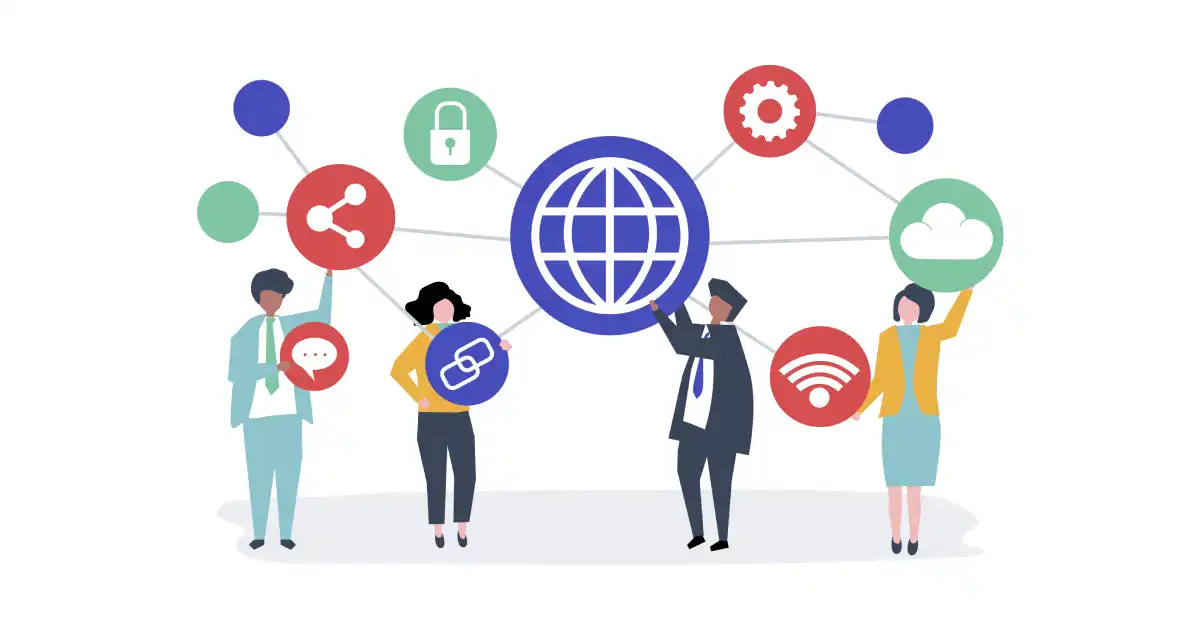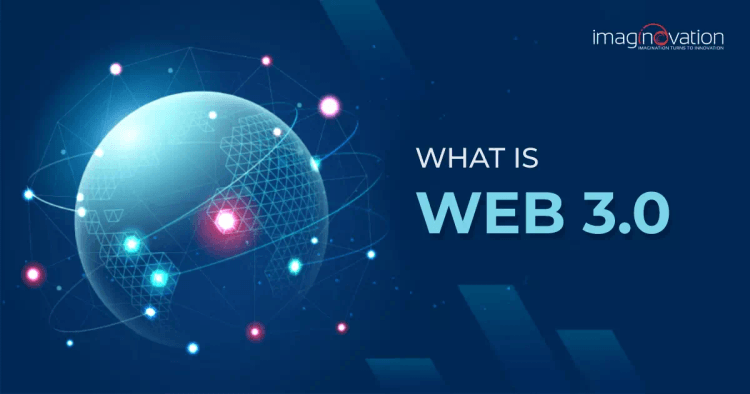New technology can make people anxious in an age of discovery and innovation. With Web 3.0, it’s innovation at the next level!
A few business entrepreneurs are still baffled by what is Web 3.0. Yet, others are thinking twice and researching relevant Web 3.0 examples to understand the architecture better.
Web 3.0 offers enterprises an innovative surface for applications in all its novelty. Plus, there are benefits to creating more transparency, efficiency, and immutability.
If you are a forward-thinking leader looking forward to leveraging the power of Web 3.0 and its exciting future use cases, then this blog is for you. In this blog post, we will demystify various facets of Web 3.0.
What is Web 3.0?
Web 3.0 built on blockchain technology lets you move beyond centralized architecture.
Its decentralized architecture is immensely promising for enterprises transcending the new generation of the web. So, platforms or applications running don’t need to be on servers owned and managed by a single central authority.
Now, businesses can develop web applications where logic will be distributed across various blockchain nodes.
The change offers more verifiability and immutability. Business entrepreneurs can experience greater transparency where changes to logic and data are visible across the network. The changes will be more easily traceable; thus, everyone will be on the same page.
Another fundamental aspect is that Web 3.0 is mainly built on three layers of technological innovation: decentralized data networks, edge computing, and artificial intelligence.
Furthermore, the founding blocks of blockchain and cryptocurrency technology will see a wonderful blend between these three technologies and other fields.
The transition from Web 2.0 to Web 3.0 is inevitable, and this new stage of the Internet offers myriad benefits, such as:
- Decentralization: Web 3.0 will be decentralized so that users can interact with data through artificial intelligence (AI) and machine learning (ML). Plus, one can find a blend of the Semantic Web concepts with AI.
- Use of AI: As just mentioned, the use of AI will be more evident. So, the technology can use the internet through algorithms used to suggest products, videos, and more to users based on their previous searches.
- Open Source: The networks are built from open-source software where an open and accessible community of developers can execute the applications in full view of the world.
Web 3.0 will scale and solve myriad business problems beyond what one can perceive.
Also Read: 10 Experts Discuss the Future of Web 3.0 and Decentralized Internet
Why Does Web 3.0 Matter?
The shift to the new wave is touted as unimaginable. So, why will it matter to you and your business landscape? Let’s check out.
- Breakthrough oligopoly markets. The switch will help transcend the current oligopoly market for the internet, where existing social media giants are making huge profits.
- Dissolve boundaries. It will help remove the boundaries between digital content and the physical world. How? The three-dimensional (3D) graphics and the convergence of augmented and virtual reality, 5G networking, and the Internet of Things (IoT) can bridge boundaries.
For example, the first 3D designs in websites and applications are already seen in landscapes including, computer games, real-estate property tours, and more. - Regain ownership of personal data. For those looking at the possibility of regaining ownership of personal data, Web 3.0 offers exciting solutions.
- Sharing data vis-à-vis privacy. One can expect more data sharing between enterprises, humans, and machines, emphasizing confidentiality and security.
- Create more resilience. Business enterprises can expect to be more resilient to change with their new mesh of adaptable peer-to-peer (P2P) communication and governance bonds between participants.
- Future proof organizations. Moreover, one can look at future-proofing entrepreneurial and investment activities by virtually removing the platform dependency risks.
The global scope of the Web 3.0 wave will be ever-expanding. Plus, one can essentially revive the spirit of the global village with more human-centric and highly personalized interactions.
Web 2.0 Vs. Web 3.0
To appreciate the new wave of Web 3.0, here’s a bird’s eye view of the key differences between Web 2.0 and Web 3.0.
| Feature | Web 2.0 | Web 3.0 |
| Introducing year | 2004 | 2016 |
| Introduced by | Tim O’Reilly, Dale Dougherty | Tim Berners Lee |
| Definitions (according to Burners-Lee) | Read and Write Web | Executable Web |
| Type of web | Social Web | Semantic Web |
| Main technologies | AJAX and JavaScript | Semantic Web, AI, ML, and Decentralized technologies |
| Number of users | Billions | Trillions |
| Directional facet | Bi-directional | Multi-user virtual environment |
| Content type | Dynamic content | Web 3.0 is still undefined |
| State of data | Owned by the network | Owned by an entity and shared through the network |
| Types of applications | Web applications | Smart applications that augment AI and ML |
| Advertising type | Interactive advertising | Behavioral advertising |
| Key focus | Tagging and end-user experience | User empowerment with emphasis on trust, privacy, and security |
| Focus area | Community focus | Individual focus |
Table 1. Quick Glance of Key Differences Between Web 2.0 and Web 3.0
What are the Features of Web 3.0 and How Will It Transform the Internet?
Semantic Data and Information
When one considers the next evolution of the Web, it involves presenting data in a semantic form.
If you’re wondering about the technology behind it, you may get a feeler through Google’s Knowledge Graph. The results of your search are more organized in a concise summary.
The semantic web leverages web technologies to generate, share, and connect content through search and analysis. The analysis is based on understanding the meaning of words rather than on keywords or numbers.
How can it help?
Well, look at it from a consumer’s perspective; it gives a practical answer where one can serve a range of information, offering possible choices rather than getting a set of web links.
Artificial Intelligence

Let’s take a quick look back at Web 2.0, it presents a lot of similar capabilities. However, it is predominantly human-based.
What does this mean?
It means that there is room for corrupt behaviors such as rigged ratings, biased product reviews, and more.
In such cases, the internet needs AI to help distinguish the genuine from the fake to offer reliable data.
Let’s take a good example of AI in action. Google’s AI system recently weeded out around 100,000 negative reviews of the Robinhood app from the Play Store after the Gamespot trading debacle.
It is said that the behemoth detected attempts of rating manipulation that were with the intent to downvote the app artificially. (Source)
So, one can expect a good blend of natural language processing in Web 3.0. Ultimately, the advances in AI will empower users with the most relevant and unbiased data.
Spatial Web and 3D Graphics
Few futurists call Web 3.0 the Spatial Web because it dissolves the physical and digital boundaries and revolutionizes graphics technology. Due to this aspect, there is a clear focus on 3D virtual worlds.
The 3D design is already used extensively in websites and services in Web 3.0. Some examples are computer games, museum guides, eCommerce, geospatial contexts, and more.
Connectivity
The Semantic Web makes Web 3.0 more autonomous, intelligent, and open. Thanks to semantic metadata, the user experience (UX) evolves and takes it to yet another level of connectivity, leveraging all the available information.
The interconnectedness of data is decentralized. So, programs can understand information conceptually and contextually, and humans can interact with machines.
Ubiquity

As we all know, ubiquity means being or having the capacity to be everywhere, especially at the same time something like being omnipresent.
In the context of Web 3.0, it makes the Internet accessible to everyone anywhere, at any time.
So, one can find that internet-connected devices will no longer be focused on computers and smartphones like in Web 2.0.
With the Internet of Things (IoT) technology, many other new types of smart devices join the connectedness to web services, which can be used everywhere.
Top 5 Web 3.0 Examples
To get a clear picture of the future use cases, let’s look at some examples of Web 3.0.
1. Sapien
With Web 3.0 social networks, business leaders can expect a complete change in platforms such as Sapien, Indorse, Sola, and more. Sapien is an excellent Web 3.0 example.
It is a tokenized, democratized social news platform that takes advantage of the Ethereum blockchain. Plus, it is highly customizable.
It intends to give users back control of their data and privacy. Moreover, it rewards content creators and fights fake news.
Users will have the opportunity to tap into the ad revenue sharing program by sharing their data with advertisers or opt out and have a whole, ad-free browsing experience.
2. IDEX
Decentralized exchanges are getting increasingly popular even though it is a slow process. The seamless user trade experience makes it attractive.
IDEX is a popular decentralized exchange for trading ERC-20 tokens in this context.
It offers an excellent interface for users, and anyone with an Ethereum wallet can start trading on the platform.
Plus, IDEX’s standardized API makes it easier than ever to integrate the existing trading software via a familiar interface with brilliant latency. So, to make the best use of IDEX or any other decentralized Ethereum-based exchange, one can use MetaMask.
3. Obsidian
Yet another exciting area where Web 3.0 can make a difference in messaging.
Apps such as e-Chat, ySign, Riot, and Obsidian powered by Web 3.0 are making the most of the advantage of blockchain, ensuring greater privacy for users.
Obsidian includes a cloud-native microservice architecture that’s suited for multi-cloud business environments. The new architecture offers a secure environment where users can communicate or even send funds to each other. Plus, it is based on STRAT and is powered by their Stratis coin.
4. AiGang
Insurance and banking are sectors that can tremendously benefit from the revolution of blockchain technology.
The implementation can benefit the users and also deter false claims. Plus, it can make the whole process seamless with minimal or no paperwork.
AiGang is a DAO insurance protocol offering crowd-sources insurance pool discovery. So, users can expect to win rewards by the prediction that’s powered by DAO smart contracts.
5. Sia
Decentralized storage implies sharing of files and data through a peer-to-peer connection. Moreover, the security in decentralized storage is top-notch, benefiting the users.
In this context, Sia is a promising decentralized storage solution, which works based on encrypting files while transferring.
Wrapping Up
In the coming years, business strategies and consumer behaviors will evolve around Web 3.0. Forward-thinking leaders are getting ready to shape their business solutions around this new era.
They know that meticulous planning can help. One should enable new use cases to ride the new emerging technology wave. Such futuristic thinking can transform businesses and create new value and empower users.
Transform Your Business with Web 3.0 Development
Get ready to transform your business beyond imagination with Web 3.0. Contact us if you are looking for a proficient solution provider who can help you develop robust Web 3.0 solutions.
We are an award-winning web and mobile app development company in Raleigh with tremendous experience in niche technologies, and we’ve helped many businesses benefit from the transformative power of game-changing mobile and web development solutions.
Let's Talk.
Ready to build an app, but not sure where to start?
We've got you covered. Click the button below to get started.





